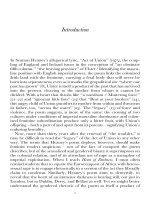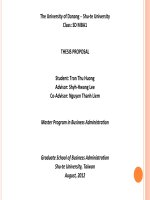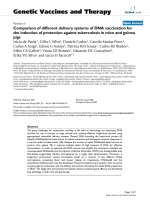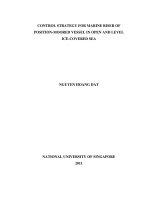Marketing plan for shell helix 2011 2013 master project in business and marketing management
Bạn đang xem bản rút gọn của tài liệu. Xem và tải ngay bản đầy đủ của tài liệu tại đây (1.01 MB, 45 trang )
TRƯỜNG ĐẠI HỌC MỞ TP. HCM UNIVERSITÉ LIBRE DE BRUXELLES
HO CHI MINH CITY OPEN UNIVERSITY
SOLVAY BRUSSELS SCHOOL
MBMM4
LÂM QUANG THỊNH
MARKETING PLAN
FOR SHELL HELIX 2011-2013
Tutor’s Name: Dr. TRẦN HÀ MINH QUÂN
Ho Chi Minh City
(2010)
ACKNOWLEDGEMENT OF COMMITMENT
I, Lam Quang Thinh, have prepared and conducted this project “Marketing Plan for
Shell Helix 2011-2013” as the final project of my MBMM4 program.
With the approval and great advices from the National B2C Sales Manager of Shell
VN Co., Ltd – Ms. Bui Thi Thanh Ha and Shell company, this project has been
accomplished by myself and served the Shell VN company as a real case.
I trust the legality of all references, information sources, updating and materials using
to complete this project.
And I am confident to submit it to Solvay MBMM Faculty, Professors and Jury
members.
ACKNOWLEDGEMENT OF APPRECIATION
Firstly, I would like to say my sincerely thanks to all who have given me fully helping
hands to finish well this project. Your valuable inputs, guidance, documents offer and
encouragement are able to treasure for my project accomplishment.
I also would like to express my great appreciation towards Dr. Tran Ha Minh Quan who
has provided me a lot of insightful feedbacks and devoted guidance to my work. I
simply can say, it is a great chance for me to be with you.
I also convey my sincere thanks to Shell VN Ltd., Co - Sales and Marketing team for
giving me the general information, findings, an opportunity to undertake about the Shell
real case for my studying of the Master of Marketing and Management program and
warmest thanks to my mentor, Ms Bui Thi Thanh Ha – National B2C Sales Manager
who was spending her valuable time to me a lot of market insights and valuable ideas
for this final project.
And, I also would like to take this opportunity to present my grateful heart to all
professors, lecturers from the Open University of Ho Chi Minh city and the Solvay
Business School. In the last one and a half year, you have full-heartedly directed us
to the broad path of updated knowledge treasure. Besides that, I would like to present
my sincerely thanks to the Post Graduate Office and our program coordinators, Mr.
Serge Bywalki and Ms. Nguyen Thi Mong Thuy and all my MBMM4 classmates for
your kind supports, useful information updating during my studying course.
Finally, I wish to express my gratitude to my family who give me strength to fulfill the
project as well as the whole program.
COMMENTS OF TUTOR
Mr. Lam Quang Thinh had proven his capability and willingness to complete this
project.
Overall: Very comprehensive.
I would like to recommend this project should be presented to Solvay MBMM Faculty,
Professors and Jury members.
Good luck and success!
TABLE OF CONTENTS
Page
ABBREVIATIONS
LIST OF CHARTS AND TABLES
EXECUTIVE SUMMARY
INTRODUCTION
PART 1: ABOUT SHELL VN CO., LTD
1. Establishment and achievement ................................................................................... 1
2. Vision and mission ........................................................................................................... 3
3. Corporate strategies and goals ..................................................................................... 4
4. Core value and sustainable competitive advantage ................................................... 4
PART 2: SITUATION ANALYSIS
1. SLEPT Analysis ............................................................................................................... 5
2. Market demand analysis ................................................................................................ 7
3. Competitor Analysis ....................................................................................................... 9
4. Shell Analysis ( SWOT ) ................................................................................................ 12
4.1 Strength ..................................................................................................................... 12
4.2 Weakness................................................................................................................... 12
4.3 Opportunity ............................................................................................................... 12
4.4 Threat........................................................................................................................ 12
5. Customer Analysis ........................................................................................................ 13
5.1 Customers’ decision-making process ........................................................................ 13
5.2 Influencers ................................................................................................................ 13
5.3 Purchasing drivers .................................................................................................... 14
5.4 Key success factors ................................................................................................... 14
PART 3: MARKETING PLAN & IMPLEMENTATION
1. Marketing Objectives ................................................................................................... 15
2. Marketing and Sales Strategies .................................................................................. 15
2.1 Segmentation & targeting consumers ........................................................................ 16
2.2 Positioning ................................................................................................................ 17
2.3 Point of difference ..................................................................................................... 17
3. Marketing Program ...................................................................................................... 17
3.1 Product .......................................................................................................................... 18
3.2 Price ............................................................................................................................... 20
3.3 Place .............................................................................................................................. 20
3.4 Promotion ...................................................................................................................... 23
3.4.1 The Marketing ATL for Shell Helix ......................................................................... 23
3.4.2 The Marketing BTL for Shell Helix......................................................................... 24
4. Marketing implementation .......................................................................................... 25
4.1 Sales and Finance ........................................................................................................ 25
4.1.1 Sales revenue ......................................................................................................... 25
4.1.2 Financial projection ............................................................................................... 25
4.1.3 Budget planning ..................................................................................................... 26
4.2 Corporate structure ....................................................................................................... 26
4.3 Marketing program implementation ............................................................................ 26
4.4 Monitoring, Evaluation and Control ........................................................................... 28
REFERENCES
APPENDICES
ABBREVIATIONS
ASEAN
Association of South East Asia Nations
ATL
Above the line
B2B
Business to Business
B2C
Business to Customer
BTL
Below the line
COGS
Cost of Goods Sold
CRM
Customer Relationship Management
DIFM
Do it for me
DIY
Do it yourself/myself
FDI
Foreign Direct Investment
FOC
Free of Charge
FWS
Franchise Workshop
GDP
Gross Domestic Product
GFD
Go Forward Distributor
GSO
General Statistic Office
HCMC
Ho Chi Minh City
IBYDIFM
I buy you do it for me
IWS
Independent Workshop
JV
Joint Venture
LPG
Liquid Petroleum Gas
MCO
Motorcycle oil
MBMM
Master in Business and Marketing Management
MMIS
Marketing Management Information System
MPV
Multi Purpose Vehicle
OEM
Original Equipment Manufacturer
PCMO
Passenger Car Motor Oil
PR
Public Relation
R&D
Research and Development
Re
Retailer
RTM
Route To Market
SLEPT
Social Legal Economic Political Technological
SWOT
Strength, Weakness, Opportunity and Thread
SUV
Sport Utility Vehicle
SIPC
Shell International Petroleum Company
Shell VN Ltd., Co
Shell Vietnam Limited Company
TOM
Top of mind
UK
United Kingdom
USD
United States Dollar
VN
Vietnam
VND
Vietnam Dong
VAMA
Vietnam Automobile Manufacturers’ Association
WOM
Word of mouth
WS
Wholesaler
WTO
World Trade Organization
LIST OF CHARTS AND TABLES
Page
CHARTS
2.1 Brand Positioning Map
2.2 Shell Lubricant Distribution System
3.1 Marketing Plan for Shell
4.1 Revenue of Shell 2000-2010
TABLES
2.1 The Number of Registered Vehicles
2.2 Capacity versus Consumption of Automobile Lubricant
4.1 Financial Projection 2011-2013
4.2 Budget Planning 2011-2013
4.3 Marketing Program
EXECUTIVE SUMMARY
Shell is the global largest manufacturer of energy and the world leader in
petrochemicals. Shell helps to meet the world's growing demand for energy in
economically, environmentally and socially responsible ways. Shell innovative
approach ensures to help tackle the challenges of the new energy future. Shell is
offering consumers a wide range of energy such as Fuel, Bitumen, Liquid Petroleum
Gas (LPG), Chemical, Lubricant…
Over 110 years operation in Vietnam, Shell is supplying a wide range of petroleum
products to meet the Vietnamese consumption demand. With the implementation of
the Vietnamese industrialization–modernization process, a lot of infrastructure
constructions and automobile manufacturing factories have being built and expanded.
And the transportation demand in Vietnam is continuously increasing year by year.
Shell has many significant success in launching Shell Advance for motorbike and Shell
Rimula for diesel engines (heavily truck, van, boat…). But Shell Helix is still new and
low perceived the automobile lubricant brand in Vietnamese market.
Basing on the Office of Transport Registration–Vietnam, there were 721.859 registered
cars in August 2007. The growth rate of Vietnamese automobile market is over 14%
year by year (versus the world growth rate of 3%) and will be even greater in the
coming years due to greater private luxury cars demand; the decline 70% of automobile
import tax rate; lots of international well known brand name of automobile
manufacturing factories in VN such as Honda, Mercedes, Mitsubishi… And the result
that, it creates chances to penetrate automobile lubricant by many lubricant companies
such as BP-Castrol, Exxon Mobil, Caltex…which are investing budget for brand building
and gain market share in this potential automobile segmentation in Vietnamese market.
And Shell Helix is recognized in top leading brand of high quality automobile lubricant
brand in over the world. This Marketing Plan has prepared for Shell VN to analyze,
outline and improve the current situation of Shell Helix by the strategies of brand
building, Sales and Marketing activities, actionable programs of good distribution
network development to enhance its brand image perception, to gain back higher
market share and to obtain the top leader position of the new automobile lubricant
segmentation in Vietnam.
The main marketing objectives anchor on intensive growth of Shell Helix for
automobile lubricant. As the current Shell business strategies in world-wide, Shell
product’s quality and package are strictly following the global Shell company standards.
Certainly, the quality, price and distribution are also highly important factors for success
in this marketplace and count a lot to sustain Shell’s competitive advantage.
With the current positive growth rate of Shell Helix around 20% and nearly 50%
revenue per year, Shell VN stretch for the goal of 40% increase in volume and 80%
increase in revenue in the three coming years 2011-2013.
And to achieve the goals, the strategic Marketing is to build Shell Helix brand
awareness with “the best quality”, “the top international lubricant brand” and “value
for money” perception. Meantime, the strategies of horizontal growth for market
penetration, general market share expansion with creating differentiation in customer
and consumer consulting services, credibility distributors, professional field Sales team,
community events to deliver the Shell’s value to protect environment...
In short, this marketing plan is also very critical for Shell Helix to gain leading
position in automobile lubricant market in Vietnam. They are considered as
milestones of Shell Marketing’s strategic planning.
The following parts will help to understand further the Shell Helix business real case
and the Marketing plan how to achieve the goals.
INTRODUCTION
The Vietnamese PCMO market is considered to have potential growth in coming time.
Shell has full PCMO lubricant products portfolio to supply this demand in the
automobile or luxury car segmentation in total lubricant market. But, Shell Helix brand
has still not yet been perceived very positive by customers and consumers. And Castrol
- the biggest competitor has prepared a lot of energy, budget and time to research,
develop Castrol all range of automobile for this new and potential market to gain the
top of mind and awareness Castrol brand. Therefore, I have decided to work on the
Marketing Plan for Shell Helix 2011-2013 in the hope that I can contribute some ideas
for the Shell VN Management Board to improve their Shell Helix business
performance, to succeed in competition and gain higher Shell Helix brand’s awareness.
The Marketing Plan for Shell Helix 2011-2013 focuses to promote Shell Helix
automobile lubricant in VN market which has been forecasted the most potential
and fast growing market in coming years.
This Marketing plan is supported by secondary information from desk research and
primary information from two research studies in the market (automobile’ s owner,
drivers) and multi-brand lubricant shops as follows:
- The “Shell Brand Imagery Assessment” Study was conducted in October 2010, with
10 in-depth interviews to automobile lubricant retailers and a sampling survey of 100
purchasers of transport service companies in HCMC.
- The “Shell Brand Health Check” Study was conducted in October 2010, amongst
three actors in the brand decision making process: retailer (n=100), car owners (n=100)
and drivers (n=100). The survey covered four main regions: HCMC, Bien Hoa and Ha
Noi.
1
PART 1
ABOUT SHELL CO., LTD
1. ESTABLISHMENT AND ACHIEVEMENT
The Royal Dutch Shell Group, commonly known as Shell, was created in February
1907 and the global energy company which headquartered in the Hague, Netherlands
and with its registered office at the Shell Center in London, United Kingdom. Shell is
the largest energy company and the second largest company in the world measured by
revenues. In 1833, Marcus Samuel opened a small shop - the primary Shell in London,
UK selling sea shells. It soon became a successful import-export business which was
managed by Marcus Samuel’s sons - Marcus Junior and Sam.
Shell is a global group of energy and petrochemicals companies for production,
transport and refining to meet the new pressures on demand. With around 101,000
employees in more than 90 countries and territories, produces around 3.1 million
barrels of oil equivalent per day and has 44,000 service stations worldwide. Shell helps
to meet the world's growing demand for energy in economically, environmentally and
socially responsible ways. Shell innovative approach ensures to help tackle the
challenges of the new energy future.
About Shell
Recognized for
technical innovation
and mega-project
d li
Employs 101,000
people in more than
90 countries
Producing the
equivalent of 2,000
barrels of oil every
Committed to social
and environmental
sustainability
Partners in innovation
with Ferrari F1 team
Shell
Active in alternative
energies — biofuels,
hydrogen, wind
One of the world’s
best known brands
Selling transport fuel
to some 10 million
customers a day
2
About Shell VN Ltd., Co, there are some milestones as follows:
1894: Shell first business established its presence in Viet Nam. Traders
started retailing kerosene in tin cans.
Through the years until 1975, Shell had successfully developed the business
of fuels retailing, accounting for more than 70% of the market in the South of
Vietnam.
1989: Shell backed Vietnam and signed the first Product Sharing Contract
with Vietnamese Government. Oil exploration was executed in Da Nang and
Vung Tau Provinces. The exploration activities were with no discovery and
withdrawn in 1996.
1991: Shell International Petroleum Company (SIPC)’s Representative
Office was set up in Hanoi
1993: SIPC set up an other office in HCMC and Shell Bitumen Ltd. was
licensed.
1995: Shell Codamo Ltd. Started operation and Shell Gas Hai Phong JV was
established with a local partner - Vinashin
1996: Shell Chemicals Ltd. was licensed.
1997: Shell Gas Sai Gon Ltd. was licensed.
2003: Shell Bitumen, Shell Codamo, Shell Chemicals and Shell Gas Sai Gon
merged into one and Shell Vietnam Ltd. was established.
2005: Shell Gas Sai Gon split from Shell Vietnam to become Shell Gas
Vietnam Ltd. Shell Gas Hai Phong is a part of Shell Gas Vietnam.
Nowadays, Shell Vietnam Ltd. operates with around 300 employees in
Bitumen, Marine, Liquid Petroleum Gas (LPG), Chemicals with high quality
water-proof paints and Lubricants with global brand Shell Helix, Shell
Advance and Shell Rimula.
3
2. VISION AND MISSION
- The objectives of the Shell are to engage efficiently, responsibly and profitably in oil,
oil products, lubricant, gas, chemicals and other selected businesses and to participate in
the search for and development of other sources of energy to meet evolving customer
needs and the world’s growing demand for a better energy future.
- Shell will be integral to the global energy needs for economic development for many
decades. The Shell role is to ensure that Shell extract and deliver them profitably and in
environmentally and socially responsible ways.
- Shell seek a high standard of performance, maintaining a strong long-term and
growing position in the competitive environments in which Shell choose to operate.
- Shell aim to work closely with all customers, partners and policymakers to advance
more efficient and sustainable use of energy and natural resources.
4
3. CORPORATE STRATEGIES AND GOALS
- To build and maintain the top leading lubricant brand in Vietnam.
- To develop and increase the Shell Helix’s market share 13% by 2013.
- To support and control up to retail outlet level in order to maximize sales volume and
to ensure consistently strong brand exposure.
- To leverage the brand image so that the Shell VN company can tap into a more
premium segmentation of the VN market.
- To be No.1 leading brand of high quality lubricant in Vietnamese market.
4. CORE VALUE AND SUSTAINABLE COMPETITIVE ADVANTAGE
The core values of Shell are honesty, integrity and respect for people are central to
Shell worldwide operations. They have formed the basis of Shell General Business
Principles for 30 years and remain as important as ever.
With the long history of establishment, Shell has strengthened itself with profound
know-how, rich experience, and worldwide distribution network. Shell provides the VN
market acceptably high quality products to protect automobile at the affordable price.
The Shell advance technology (Fully synthetic) is another competitive advantage of
Shell to sustain in an increasing competition environment in the next coming years.
5
PART 2
SITUATION ANALYSIS
SLEPT
ANALYSIS
MARKET
ANALYSIS
CUSTOMER
ANALYSIS
SWOT
ANALYSIS
COMPETITOR
ANALYSIS
1. SLEPT ANALYSIS
1.1 Social factors
- With a new opening economic growth and huge potential consumption market,
Vietnam is the potential market for many multi-national companies which are investing
and establishing long term business. The Vietnamese government has taken several
reform measures in order to improve the country's competitiveness and business
environment. Vietnamese market is considered the fast consuming movement.
- Vietnam has a large population over 87 millions. With a youthful population and
continuing strong economic growth, together with its large consumer markets with
rising income. The Vietnam's consumer market is still in the early stages of
development but has been one of the fastest growing markets in the region as a result of
robust economic growth and rising disposable income.
- The fast industrialization and improving Vietnamese living standards lead to high
social mobility, i.e. the expenditure on transportation is getting higher. As the VN
economy is expected to grow stronger in the coming years, the real growth of consumer
expenditure is forecast to reach 7.3% in 2010. Sectors which are expected to grow
strongly in 2010 include education, household goods and services and transport.
6
1.2 Legal factors
- Currently, the distribution of petrol and gasoline is managed by Vietnamese
government. And the Vietnam government has launched many decrees for
development the other petroleum such as bitumen, marine energy, liquid petroleum
gas, chemicals and lubricants… The current distribution network of lubricant is opened
and set up by both the foreign multinational and local companies.
1.3 Economic factors
Vietnam has been one of the fastest–growing economies in Asia and ASEAN countries
over the past five years, average growth of 8% per year. Real GDP growth is estimated
at 6.4% in 2010. The opening up of its own market will bring mixed blessing for
Vietnam. Investment together with consumption, is key driver of Vietnamese growth.
In early 1970, Vietnam has fully joined WTO, i.e. cheaper importing tax and increasing
competition will reduce inflation, which is currently running at 7.7%, and thus increase
purchasing power for Vietnamese consumers. It will offer more chances to import and
export lubricant with other countries in the world.
Table 1: The Vietnam Demographic and Economic Indicators
Demographic and economic indicators
2006
2007
2008
199,004.07
222,185.10
241,367.88
256,546.27
275,639.22
Real GDP Growth
(% growth)
8.23
8.42
6.22
5.23
6.47
Inflation (% growth)
7.40
8.86
22.41
7.00
9.04
38,273.51
45,591.50
60,840.77
63,982.68
68,185.05
GDP Measured at
Purchasing Power Parity
(million international $)
Consumer Expenditure
(US$ million)
2009
2010 (est.)
Annual Gross Income
47,382.91
56,479.26
75,265.32
79,360.12
(US$ million)
Annual Disposable Income
39,937.33
47,658.31
63,556.51
66,964.47
(US$ million)
Source: The VN Statistic in 2009 - Vietnam Demographic and Economic Indicators
84,535.33
71,398.12
7
1.4 Political factors
- The Vietnam government appears determined to push ahead with the market oriented
reforms necessary to double 2000’s GDP by 2010, as targeted.
- The government shows to work more efficiently and effectively, with the obviously
seen red tape cut off to attract more foreign investment and create stable business
environment in Vietnam.
1.5 Technological factors
With the current Foreign Direct Investment (FDI), the oversea businessmen invest
money and high technology into their business in VN. For Shell VN, Lubricants are
produced in local factory and imported many petroleum sources from Shell’s group
strictly following the global Shell group’s formula and quality standards.
2. MARKET ANALYSIS
Vietnam is in the trend of fast urbanization and infrastructure development, which
facilitates the increase steadily of vehicles.
Table 2: The Vietnam Transport Registration
The number of vehicles in Vietnam
Total
2003
2004
2005
2006
August 2007
461,000
528,500
602,000
655,800
721,859
137,200
178,200
209,000
230,000
272,865
1 Passenger car
=< 9 seat
2 Mini-bus 1
10 - 16 seat
47,600
42,600
47,000
50,000
53,126
3 Mini-bus 2
17 - 25 seat
10,000
7,700
8,000
9,000
10,258
4 Bus
> 25 seat
21,800
21,700
25,000
27,000
29,845
5 Light truck
=< 2 ton
50,200
79,800
95,300
109,000
121,011
6 Truck
> 2 ton
116,800
118,000
130,500
140,300
142,306
7 Special purpose vehicles
49,200
55,500
58,200
60,000
61,621
8 Others
28,200
25,000
29,000
30,500
30,827
Source: The Office of Transport Registration – Vietnam (2007)
8
As illustrated in the above table, the number of vehicles are steady increasing average
14% every year (versus the world growth rate of 3%). This growing rate will be even
greater in the coming years as bellows:
-
The transportation expenditure (14%) is the top No. 2 grading below the highest
consumer’s spending of food and beverage (38%).
-
The VN government is developing big plan to improve infrastructure network.
-
As the Circular 184/2010 from the Finance Ministry, the import tax for
automobile under 9 seats will decrease 1 to 3% more as current (83%); its
effective from 1st January, 2011.
-
Having a greater demand of business cars, private luxury cars, sport or fashion
cars, especially highest demand in Ho Chi Minh City and Hanoi city.
-
Apart from the imported automobiles, there are lots of international well known
brand name of automobile manufacturing factories in VN such as Honda,
Mercedes, Mitsubishi…
-
Currently, there are many international and local lubricant companies which are
supplying the automobile power demand by launching some initial products.
Table 3: The Vietnam consumer expenditure by sector (2009)
st
Source: Euro monitor International from National statistical offices (1 June, 2010)
9
The Vietnamese PCMO market size estimate is 14 million liters with about average
growth 45% every year for passenger cars. It will be a potential chance to launch Shell
Helix portfolio in the VN automobile segmentation.
Table 4: VAMA 2009 Report and Lubricants consumption estimation
187
200
140
150
88
100
50
0
102
95
75
14 19
PCMO
MCO
Transport oils Industrial oils
Y2008
14
88
140
75
Y2012
19
102
187
95
Source: VAMA 2009 Report
3. COMPETITORS ANALYSIS
By focusing on brand and availability, BP-Castrol has become the clear leader and a
dominant market share and position in the VN automobile market.
- Competitive pricing
Cost
- Big promotion
- Cost advantage
- Large Retails network and depots.
- Local brand
- Weak distribution network
- Strong distribution network
- High share of Mobil
- Top of mind brand
- Multi-grade lubricant
- High spending in ATL & BTL
- Much focus on premium segments
- Nationwide distribution network
Brand
Value
- High quality
- Upgrade the portfolio and
positioning of brand (BP-Castrol)
- Nationwide distribution network
- Total still weak in VN
- Less focus to develop Shell Helix
- But Total is very committed to
VN market by acquiring ExxonMobil in Viet Nam
- Strengthening distribution network
10
The findings of the market survey conducted among three actors (retailers, automobile’
s owners and drivers) in September and October 2010 show that Castrol is apparently
the direct competitor of Shell across regions on availability, brand awareness,
distribution (retailer), buyers and users. (Appendix 1)
- Shell Helix is just right behind Castrol on all levels of brand awareness in general and
in particular HCMC, Hanoi and Bien Hoa.
- In addition, Castrol especially appears leading in automobile lubricant segment with
high brand awareness among retailers, high purchase levels among owners.(Appendix
8)
- Last but not least, Castrol Edge is also perceived better Shell Helix. This is probably a
critical reason for owners tentatively to be more loyal to Castrol than Shell Helix.
- Castrol clearly have similar positioning as Shell is well-perceived of “reliable”, “wellknown”, “consistent quality” and “technology advanced” brands in terms of
positioning. (Appendix 7)
11
12
4. COMPANY ANALYSIS
The automobile market volume is expected to have grown in Vietnam. And the
bigger power demand for automobile has increasing and continue to grow in near
future. Shell has experienced in providing of high quality lubricant’s demand. In
order to maximize the current Shell VN revenue and market share, let’s make a
SWOT analysis about Shell VN and the current Vietnamese market.
4.1/ Strength
4.2/ Weakness
High brand share preference
• Strong international corporate brand, but still weaker than
BP-Castrol.
Product portfolio
• OEM recommendation.
• Good perception on product quality and technology as
highlighted in the technical partnerships with Ferrari.
Sales & Marketing activities
• Competitive promotion for Trade, Influencers, Consumers
(Strong Trade Loyalty program currently).
• Shell Drill Implementation with focus on FWS in key cities
using suspect list identified.
• Route To Market Project implementation to set up the strong
distribution network with Go Forward Distributors.
• High dependence on value brands (80% of total volume is
Shell
Helix 40)
• High COGS of Shell synthetic and expensively to sell (low
contribution of synthetics at 2-2.5% of total volume)
• Low market penetration and visibility
• Weak Outlet Branding/Merchandising (versus BP-Castrol)
• Weak in distribution network, low penetration against key
competitor BP-Castrol, especially in FWS & IWS.
• Lack of brand building activities
• Less budget for Shell Helix brand building and push sales up
• Few prints and billboard, TVC advertisements so far
• Unclear differentiation message of Shell Helix for SUV, MPV,
customers, consumers
4.3/ Opportunity
4.4/ Threat
Growing automobile markets
• More modern & expensive cars imported which can be seen
as Helix Ultra customers in future.
• Increasing high quality lubricants for expensive cars.
• Lots of automobile manufacturers in VN
• Still low penetration (2% only) in Synthetic lubricant.
• Some merging trend of Total acquired Exxon-Mobil; Motul
acquisition of local Vilube completion.
• Caltex Chevron downsizing distributors network.
Declining segments in Automobile Wash & IWS in key
cities:
• High expensive of lands cost
• Increased warranty period of cars (From 1-2 years to 2-3 years)
resulting in longer retention by FWS.
• FWS sectors are tied with OEM contract, less chance to
penetrate in
• Low price and extended market credit strategies by localplayers.
• Strong presence of global brands in VN (BPCastrol/Mobil/Caltex…)
• Castrol has the top brand awareness, deeply penetration with
strong support of ATL and BTL activities for Castrol Magnatec &
Edge
13
5. CONSUMER ANALYSIS
Consumer patterns have changing, consumers begin to demand the lifestyles
associated with modern technology, convenience and comfort, e.g. better
transportation service. Vietnam's urban population has become more affluent,
providing good opportunities for consumer businesses. And now, there are the new
trends of more young Vietnamese consumers who are willing to buy new private
expensive cars, luxury houses and apartments... and are expected to grow more
rapidly in the coming years.
5.1 Consumer decision-making process
It’s honestly to say that lots of Vietnamese consumers who have not enough well
knowledge of lubricant, thus the decision making process is involved many
influencers or influence factors. There are two main influencers in the decision
making process: buyers and users. The buyers of lubricant can be individual car
owners with personal usage, OEMs and some transport service companies for
commercial usage. However, the users of lubricant are not often the same person
with the buyer. Most of the time, the direct users of lubricant are drivers who are
working for car owners or transport service companies. If having the car owner’s
usage decision of which lubricant’s brand, the drivers will follow. (Appendix 7)
5.2 Influencers
The research findings highlight some insights underlying in the decision making
process of this kind of product (Appendix 4,5,6) in details:
- The buyers are mostly dependable on their own experience, memory when
comes to the decision of buying lubricant.
- Colleagues in transport industry are the second most influencing factor to their
buying behaviors.
- The following factors are also found very important are drivers and sellers’
recommendation.









